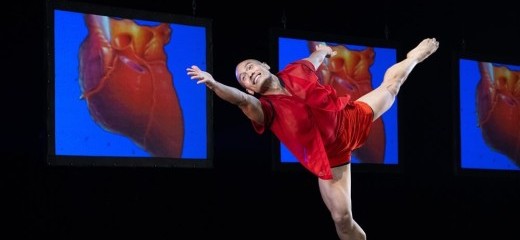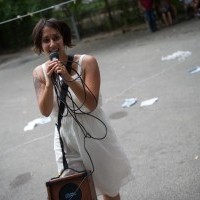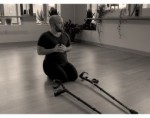
Still/Here: 30 Years Later
by Kristen Shahverdian
It’s been 30 years since the premiere of Still/Here by the Bill T. Jones/Arnie Zane Company, and although that’s reason enough to mount a reprisal of it, it does raise the question - how will a piece so of its time resonate today?
Still/Here was born from “survival workshops” led by Bill T. Jones and documented by Gretchen Bender from 1992-1994. The participants in the workshops form the essence of the Still/Here. Although the workshops were for people with all manner of life-threatening illnesses, I remember and place Still/Here in a specific time in history, which makes the AIDS epidemic ever-present to me in the work. In 1994, AIDS became the leading cause of death for all Americans ages 25 to 44. I wonder how today’s Still/Here dancers, most of whom were not born by 1994, will channel the particular weight of that time into their performances. There is an invitation in the reprisal to be both a witness to the past and to reflect upon what this present moment brings to the work.
I never saw Still/Here, having only just discovered contemporary dance when the work premiered, but later, as I taught dance classes for college students, I spent a class each semester diving into it with my students, and I must have watched the documentary of its making at least 10 times. In the documentary, you get to know the participants in the workshops. They are the focal point rather than the company’s dancers; the workshop participants are the creators whose stories, gestures, and phrases will become the choreography and soundscore.
Still/Here is also famous for its controversy - the dance critic Arlene Croce wrote a piece for The New Yorker explaining her refusal to see the piece and her strong opinions of the work she dubbed “victim art.” Watching the piece now, I find myself less interested in that discussion. Time offers a distance from the origin of Still/Here. Questions of victimhood and how or why we tell whose stories fell to the wayside as I watched an incredibly athletic dance that exhibited care, strength, and presence. If anything, this was the biggest surprise to me in the live performance - that it was for me, now, first and foremost a dance piece.
The reprisal of Still/Here is presented at the Howard Gilman Opera House at BAM. The piece opens with all of the dancers on stage dressed in white. One at a time, a dancer says a name while making a gesture: one hand covering an eye while the other arm reaches forward; outstretched arms that sweep like a bird in flight; arms wrapped around oneself in an embrace. Each person named participated in the survivor workshops and created the gestures during the workshops. Most of the motions are reflective and embody self-care, but some signal a fight - holding a bent arm with a fist, or a sassy twirl of the wrists and hip bump that’s the movement for “Mary” - said to us as “Mary, do the Mary.” The gestures are simple and obvious, but I see in them a sweet awkwardness and humbleness, even as they are transposed onto some of the most nimble dancers in the world.
Soon after, a dancer is downstage, on a slight diagonal, balancing in an arabesque. Their focus is out and down as if trying to see what is there, looking for a glimpse of what is next; this motif reappears over and over throughout the two-hour piece. At the same moment that I reflect upon themes of traveling and journey, I hear Odetta sing, “Can someone please open the door?” Odetta’s vocalizations accompany the soaring melodies of the first act’s score, “Still”, composed by Kenneth Frazelle. As athletic as Still/Here is, there’s also a lot of care and care-taking between the dancers. Hands are tenderly placed on a shoulder, or a dancer leans back into another who supports their entire body.
Throughout the work, screens move forward, back, and up and down. On them, I see original videos of participants from the survivor workshops, a face sometimes still and soundless, or the original gestures performed by the creators. In one clip, we listen and watch a woman describe the end of her life - she tells us who will be there, describes the sunlight streaming into the room, the bells she hears, and how she tries not to cry for her sons. She nods throughout the telling, like an affirmation to herself. As I think back on the piece, this remains my most vivid memory, rather than what any of the dancers on the stage were doing while she spoke.
Even amidst the heaviness of some of the narration, there is a vibrancy throughout the piece, particularly in the lighting design by Robert Wierzel, who uses solid blues, pinks, and yellows on the screens.
The second half introduces us to “Here,” with music composed and arranged by Vernon Reid. The costumes and the screen along the back of the stage are all in a saturated red, and pillars carve the light evenly across the back of the stage, creating alternating patterns of red and dark shadow. This second half repeats many of the same movement phrases and gestures of the first - perhaps too many of them, but it also feels different. It’s more chaotic, more urgent. An image is shown on the screens of a beating heart, and another time the screen frantically moves through pictures in a blur. The heart’s image strikes me as obvious, and the animation is a bit dated; the frantic movements and sounds push chaos at me, yet nothing bothers me about it. The layering of sounds, lights, colors, stories, and movements, performed by fantastic dancers, creates an immersive experience.
Nearing the end, the dancers join up in a circle, and each spins, dropping into a deep plié where they grab hands for a moment, only to release and spin in the opposite direction, plié and grab hands again. While spinning, I hear names spoken on the recording; sometimes, it’s hard to discern through the cacophony of other sounds. Dancers break free and run, but are pulled back into the group. Emotion bubbles up for me most from the stories told by the workshop participants; their stories break through the noise.
The distance of 30 years offers another realization - that many of the workshop participants have passed. This brings with it a different kind of gravitas and emotion. It’s like the way I can know the sorrow coming at the end of a story, and still be moved by it - all the more so for knowing it.
Still/Here, Bill T. Jones/Arnie Zane Company, Peter Jay Sharp Building, Howard Gilman Opera House, Brooklyn Academy of Music (BAM) as part of its Next Wave 2024 & Emerging Visions Festival, Oct. 30- Nov. 2, 2024.
Homepage Image Description: A group of dancers all dressed in white are clumped together in front of a blue backdrop that has 2 pillars running down them. The dancer in the front is kneeling with her arms lifted to the side with bent elbows and her hands in fists. Behind her are two couples leaning away from center and each has one arm raised with a bent elbow and hand in a fist. All of the dancers look either down or out, with a serious and contemplative expression.
Article Page Image Description: A man in red shorts and a red shirt is standing on one bent leg while his other leg is stretched out behind him high in the air with his toes pointed. One of his arms is stretched forward with his palm lifted and fingers spread. There is a smile on his face as he reaches strongly forward with his arm and back with his leg. Behind him there are 3 large images of a heart on a blue screen.
By Kristen Shahverdian
November 17, 2024










